Articles
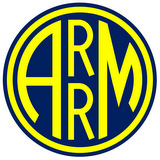 If you have an article you’d like to share dealing with Appalachian modeling or operation, please contact the site!
If you have an article you’d like to share dealing with Appalachian modeling or operation, please contact the site!
The following is a listing of ALL articles on Appalachian Railroad Modeling. Use the sub-menu from the “Articles” tab above for more tailored results.
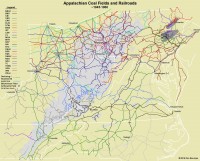
The evolution of coal-hauling railroads in the Appalachians is fascinating, especially over the last 60 years. Six years ago, Appalachian Railroad Modeling published its first map of the coal fields and railroads circa 1950. While it was informative, these four maps go well beyond the original to show how Appalachian railroading changed over time, and together they tell a fascinating story of growth, downsizing, consolidating and rebirth. Based on the resources I had, it was difficult to tell when certain lines were abandoned, especially in the 1945 and 1970 maps, so many of the dashed lines in the 1945 map may have been active, and many of the dashed lines in the 1970 map may have been abandoned decades before. I learned … Read more →

RJ Corman Operations at Stifflertown, PA
by Henry Statkowski Photos and figures by the author
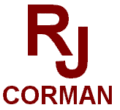 R.J. Corman’s Pennsylvania Line operates a coal train between Rosebud Mining’s Stifflertown, Pennsylvania mine in southwestern Clearfield County and their Bigler coal preparation plant in northeastern Clearfield County. It’s a 60-mile run using SD40-2 variants (SD40-2s & SD40T-2s) and 100-ton coal gondolas, formerly handled by a multitude of coal trucks (locally referred to as “coal buckets”) over public highways. The over-the-road transport was labor intensive – rail transport over already-existing rail lines was a logical step. Loading the train at Stifflertown is performed by front-end loaders at a coal dock, with the … Read more →
R.J. Corman’s Pennsylvania Line operates a coal train between Rosebud Mining’s Stifflertown, Pennsylvania mine in southwestern Clearfield County and their Bigler coal preparation plant in northeastern Clearfield County. It’s a 60-mile run using SD40-2 variants (SD40-2s & SD40T-2s) and 100-ton coal gondolas, formerly handled by a multitude of coal trucks (locally referred to as “coal buckets”) over public highways. The over-the-road transport was labor intensive – rail transport over already-existing rail lines was a logical step. Loading the train at Stifflertown is performed by front-end loaders at a coal dock, with the … Read more →
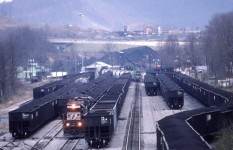
by Harry J. Dolan (Retired NS Trainmaster)
 Working the N&W’s Norton yard in Southwestern Virginia required sets of six-axle locomotives. The yard has a 1% descending grade from west to east. Tracks 1 thru 8 (original numbering) hold 40 hoppers each; at 100 tons each, that is 4000 tons. One six-axle unit at Norton couldn’t handle much more than switching the caboose track. One Dash-8 would not even pull the 21 loads out of Norton Coal (switch off N&W Main at the east end of yard that crossed the Miller Yard Main of Interstate in Norton).
Working the N&W’s Norton yard in Southwestern Virginia required sets of six-axle locomotives. The yard has a 1% descending grade from west to east. Tracks 1 thru 8 (original numbering) hold 40 hoppers each; at 100 tons each, that is 4000 tons. One six-axle unit at Norton couldn’t handle much more than switching the caboose track. One Dash-8 would not even pull the 21 loads out of Norton Coal (switch off N&W Main at the east end of yard that crossed the Miller Yard Main of Interstate in Norton).
Just to give you an example as to what tonnage and a 1% grade will do … Read more →
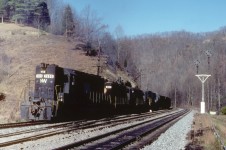
by Harry J. Dolan (Retired NS Trainmaster)
 The N&W used train symbols to identify its trains. Train symbols are different from train numbers. Train numbers are used to designate scheduled trains (those who’s authority to occupy the main track between stations is listed in the Division Employees Timetable). Train symbols, on the other hand carry no timetable authority and do not authorize a train or engine to occupy the main track between stations. Train symbols, at least on the N&W, pretty much reflected the initial and final terminal of the train or perhaps the primary type of traffic handled on that train. For instance, the train … Read more →
The N&W used train symbols to identify its trains. Train symbols are different from train numbers. Train numbers are used to designate scheduled trains (those who’s authority to occupy the main track between stations is listed in the Division Employees Timetable). Train symbols, on the other hand carry no timetable authority and do not authorize a train or engine to occupy the main track between stations. Train symbols, at least on the N&W, pretty much reflected the initial and final terminal of the train or perhaps the primary type of traffic handled on that train. For instance, the train … Read more →
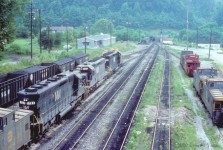
by Harry J. Dolan (Retired NS Trainmaster)
 Big pusher consists (24 powered axles) were only used on loaded trains. “Time Freight” (General or Mixed Freight) pushers were limited to 14 powered axles. The former Southern pushed against cabooses, empty, and light loaded cars. As such, they limited pushers to 14 powered axles (example, two 4 axle & one 6 axle conventional units). High adhesion locomotive axles were counted as 1 1/3 conventional traction motors, hence, a C40-8 or an SD-60 with 6 actual axles would be counted as 8 axles. The N&W, on the other hand, pushed against 100 ton or heavier loads and limited their pusher consists to 24 powered axles (4 conventional SD’s … Read more →
Big pusher consists (24 powered axles) were only used on loaded trains. “Time Freight” (General or Mixed Freight) pushers were limited to 14 powered axles. The former Southern pushed against cabooses, empty, and light loaded cars. As such, they limited pushers to 14 powered axles (example, two 4 axle & one 6 axle conventional units). High adhesion locomotive axles were counted as 1 1/3 conventional traction motors, hence, a C40-8 or an SD-60 with 6 actual axles would be counted as 8 axles. The N&W, on the other hand, pushed against 100 ton or heavier loads and limited their pusher consists to 24 powered axles (4 conventional SD’s … Read more →
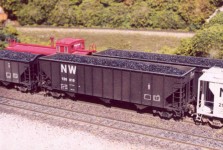
Realism means more than just nice models, it also means a nice model mix
by Dan Bourque
Most people realize that realism on a model railroad is not achieved by one or two nice models alone. Rather, realism is created as the sum of many factors. Good-looking scenery, a good trackplan and realistic-looking models are often the primary things our eyes notice right away. However, there are many more subtle characteristics which add to realism like a consistent era for all the models, the right amount of cars and locomotives on the layout and realistic operations when things are running. Another subtle way to add realism which many folks don’t think about is the MIX of your freight car … Read more →
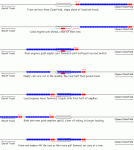
by Henry Statkowski
Photos and figures by the author
 The R. J. Corman Railroad, Pennsylvania Line (Reporting Marks “RJCP”), operates over former New York Central and Pennsylvania trackage in West Central Pennsylvania (including a five-mile stretch over former Baltimore & Ohio (Buffalo, Rochester & Pittsburgh) and the joint NYC/PRR Cherry Tree & Dixonville Railroad). Operating westward from its connection with the ex-Conrail (now Norfolk Southern) Buffalo Line at Keating, PA, the RJCP continues westward to its hub at Clearfield, PA. From here, branches reach out in various directions to those coal-loading facilities still in operation. The coal-loading facility at Clymer, Pa. is one of them.
The R. J. Corman Railroad, Pennsylvania Line (Reporting Marks “RJCP”), operates over former New York Central and Pennsylvania trackage in West Central Pennsylvania (including a five-mile stretch over former Baltimore & Ohio (Buffalo, Rochester & Pittsburgh) and the joint NYC/PRR Cherry Tree & Dixonville Railroad). Operating westward from its connection with the ex-Conrail (now Norfolk Southern) Buffalo Line at Keating, PA, the RJCP continues westward to its hub at Clearfield, PA. From here, branches reach out in various directions to those coal-loading facilities still in operation. The coal-loading facility at Clymer, Pa. is one of them.
… Read more →

by Dan Bourque
In order to effectively model coal operations on your layout, you first have to understand how a mine run works on the prototype. In this article, I’ve drawn up a make-believe yard and branch line that our mine run (known as a “shifter” on some railroads like the N&W and Clinchfield) has to work. Like tipples, no two mine runs are exactly alike, and each has its own set of operating challenges. Our mine run will take us through several of these challenges and how a crew might handle them.
 Our mine run starts in the yard with 2 … Read more →
Our mine run starts in the yard with 2 … Read more →

by Dave Beach
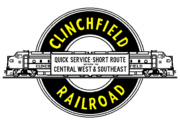 The diesel era helper operations on the South-end up to Altapass were really interesting. I think the pushers at least for coal trains often tied on before Erwin–maybe Johnson City or even Kingsport. I can remember seeing pushers cut into coal trains north of Erwin, but this was before the JC cutoff was built. I don’t know that they ever cut off at Poplar or were put on at Spruce Pine. I suppose that there could have been an occasional boost from the Spruce Pine switcher but doubt that it was a planned operation.
The diesel era helper operations on the South-end up to Altapass were really interesting. I think the pushers at least for coal trains often tied on before Erwin–maybe Johnson City or even Kingsport. I can remember seeing pushers cut into coal trains north of Erwin, but this was before the JC cutoff was built. I don’t know that they ever cut off at Poplar or were put on at Spruce Pine. I suppose that there could have been an occasional boost from the Spruce Pine switcher but doubt that it was a planned operation.
The cutoff at Altapass (or Ridge siding to be more exact) … Read more →
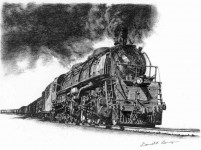
by Harry Sandlin
 The CRR used pushers and double-headed trains in the post war steam era as train tonnage increased. However, evidence of steam era pushers does not seem nearly as easy to find as in the diesel era. When Steam Ran the Clinchfield by James Goforth has several photos of double-headed trains, including merchandise trains. In Goforth’s book, the most dramatic evidence of pusher service is a photograph on page 100 of a southbound coal train with L-1 Mallet No.706 as pusher. The train had stopped to take on water at Boone, TN early in the afternoon of June 1, 1947. Class E-1 4-6-6-4 No. 656 shoved from the … Read more →
The CRR used pushers and double-headed trains in the post war steam era as train tonnage increased. However, evidence of steam era pushers does not seem nearly as easy to find as in the diesel era. When Steam Ran the Clinchfield by James Goforth has several photos of double-headed trains, including merchandise trains. In Goforth’s book, the most dramatic evidence of pusher service is a photograph on page 100 of a southbound coal train with L-1 Mallet No.706 as pusher. The train had stopped to take on water at Boone, TN early in the afternoon of June 1, 1947. Class E-1 4-6-6-4 No. 656 shoved from the … Read more →
 If you have an article you’d like to share dealing with Appalachian modeling or operation, please contact the site!
If you have an article you’d like to share dealing with Appalachian modeling or operation, please contact the site! 





 R.J. Corman’s Pennsylvania Line operates a coal train between Rosebud Mining’s Stifflertown, Pennsylvania mine in southwestern Clearfield County and their Bigler coal preparation plant in northeastern Clearfield County. It’s a 60-mile run using SD40-2 variants (SD40-2s & SD40T-2s) and 100-ton coal gondolas, formerly handled by a multitude of coal trucks (locally referred to as “coal buckets”) over public highways. The over-the-road transport was labor intensive – rail transport over already-existing rail lines was a logical step. Loading the train at Stifflertown is performed by front-end loaders at a coal dock, with the …
R.J. Corman’s Pennsylvania Line operates a coal train between Rosebud Mining’s Stifflertown, Pennsylvania mine in southwestern Clearfield County and their Bigler coal preparation plant in northeastern Clearfield County. It’s a 60-mile run using SD40-2 variants (SD40-2s & SD40T-2s) and 100-ton coal gondolas, formerly handled by a multitude of coal trucks (locally referred to as “coal buckets”) over public highways. The over-the-road transport was labor intensive – rail transport over already-existing rail lines was a logical step. Loading the train at Stifflertown is performed by front-end loaders at a coal dock, with the … 
 Working the N&W’s Norton yard in Southwestern Virginia required sets of six-axle locomotives. The yard has a 1% descending grade from west to east. Tracks 1 thru 8 (original numbering) hold 40 hoppers each; at 100 tons each, that is 4000 tons. One six-axle unit at Norton couldn’t handle much more than switching the caboose track. One Dash-8 would not even pull the 21 loads out of Norton Coal (switch off N&W Main at the east end of yard that crossed the Miller Yard Main of Interstate in Norton).
Working the N&W’s Norton yard in Southwestern Virginia required sets of six-axle locomotives. The yard has a 1% descending grade from west to east. Tracks 1 thru 8 (original numbering) hold 40 hoppers each; at 100 tons each, that is 4000 tons. One six-axle unit at Norton couldn’t handle much more than switching the caboose track. One Dash-8 would not even pull the 21 loads out of Norton Coal (switch off N&W Main at the east end of yard that crossed the Miller Yard Main of Interstate in Norton).






 The diesel era helper operations on the South-end up to Altapass were really interesting. I think the pushers at least for coal trains often tied on before Erwin–maybe Johnson City or even Kingsport. I can remember seeing pushers cut into coal trains north of Erwin, but this was before the JC cutoff was built. I don’t know that they ever cut off at Poplar or were put on at Spruce Pine. I suppose that there could have been an occasional boost from the Spruce Pine switcher but doubt that it was a planned operation.
The diesel era helper operations on the South-end up to Altapass were really interesting. I think the pushers at least for coal trains often tied on before Erwin–maybe Johnson City or even Kingsport. I can remember seeing pushers cut into coal trains north of Erwin, but this was before the JC cutoff was built. I don’t know that they ever cut off at Poplar or were put on at Spruce Pine. I suppose that there could have been an occasional boost from the Spruce Pine switcher but doubt that it was a planned operation.